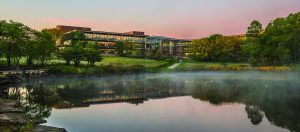Suburbs, city make their pitches to Amazon
By Kevin Beese Staff reporter — October 22, 2017
The River District gives an opportunity for Amazon to create a neighborhood that is pedestrian, bike and transit friendly while convenient to regional commuters and international travelers.
Ready for the Amazon Tower? Or how about McAmazon?
Eight Chicago sites and two suburban business campuses are being pitched as potential homes to Amazon’s second headquarters, being labeled HQ2.
The sites include a package of 18 million square feet of space in five downtown buildings including Willis Tower, and the McDonald’s campus in Oak Brook that the hamburger giant is vacating as it relocates to Chicago’s Near West Side.
“The sites identified in Chicago’s bid for HQ2 demonstrate the region’s unparalleled potential to support Amazon’s future growth,” Chicago Mayor Rahm Emanuel said. “The combination of these prime locations with the country’s most educated population, diversified economy and connected transportation system make it clear that Chicago is the ideal city for Amazon’s second headquarters as the company continues to expand.”
The second Amazon headquarters is expected to bring billions of dollars in investment from the Washington State-based company and create an estimated 50,000 jobs.
“We expect HQ2 to be a full equal to our Seattle headquarters,” Amazon founder and CEO Jeff Bezos said when announcing the search for a second headquarters site last month. “Amazon HQ2 will bring billions of dollars in upfront and ongoing investments, and tens of thousands of high-paying jobs. We’re excited to find a second home.”
Illinois is well-suited for Amazon, according to Gov. Bruce Rauner.
“Our state possesses unmatched business, education, technology, logistics, distribution and academic research assets,” Rauner said. “These are the core attributes of a community in which Amazon can thrive. More important, they represent a foundation for talent-rich, innovative growth for generations to come.”
The 10 potential Amazon sites in the Chicago area are:
Chicago
Downtown Gateway District – Using space in Willis Tower, the old Chicago post office and Union Station, 18 million square feet of office space would be available through five existing buildings and seven development sites.
- City Center Campus – Located in the Loop, the Amazon campus would be fully integrated into existing infrastructure and a multi-modal transportation network.
- Lincoln Yards – Comprising more than 70 riverfront acres between Bucktown and Lincoln Park.
- River District – An opportunity for Amazon to create a neighborhood that is pedestrian, bike and transit friendly while convenient to regional commuters and international travelers.
- Fulton Market – Home to a host of start-ups and corporate headquarters re-locations, including Dyson, Glassdoor, Google, Uber, McDonald’s and WeWork.
- Illinois Medical District – An area just west of Downtown that is well-served by transit and is home to three colleges, four medical centers and numerous public/private technology enterprises.
- The 78 – The largest undeveloped parcel of land in Downtown Chicago, a 62-acre site. It is also where the University of Illinois envisions its Discovery Partners Institute, a collaboration of research universities, businesses and public-sector partners to spur growth in the Illinois economy.
- Burnham Lakefront – Extending from McCormick Place to 31st Street Beach and Marina, the site covers more than a half-mile of Lake Michigan frontage, offering 12 million square feet of mixed use development land.
Suburbs
- Schaumburg – The former global headquarters of Motorola for more than 50 years. The 265 acres would be transformed into an urban, walkable neighborhood with Amazon as the anchor.
- Oak Brook – McDonald’s headquarters for more than 40 years. The site has its own private entrance and includes four existing buildings, an international headquarters building, a Prairie-style headquarters office building, a training center with its own laboratory, a kitchen area, a Hyatt-managed hotel and two lakes.
The release of the Chicago area bid gave no indication as to tax incentives that the municipalities and state are offering Emanuel and Rauner said to ensure the competitiveness of the Chicago area’s bid, no additional details will be made available at this time.
In choosing the location for its HQ2, Amazon has said it has a preference for:
- A metropolitan area with more than 1 million people.
- A stable and business-friendly environment.
- Urban or suburban locations with the potential to attract and retain strong technical talent.
- Communities that think big and creatively when considering locations and real estate options.
— Suburbs, city make their pitches to Amazon —




